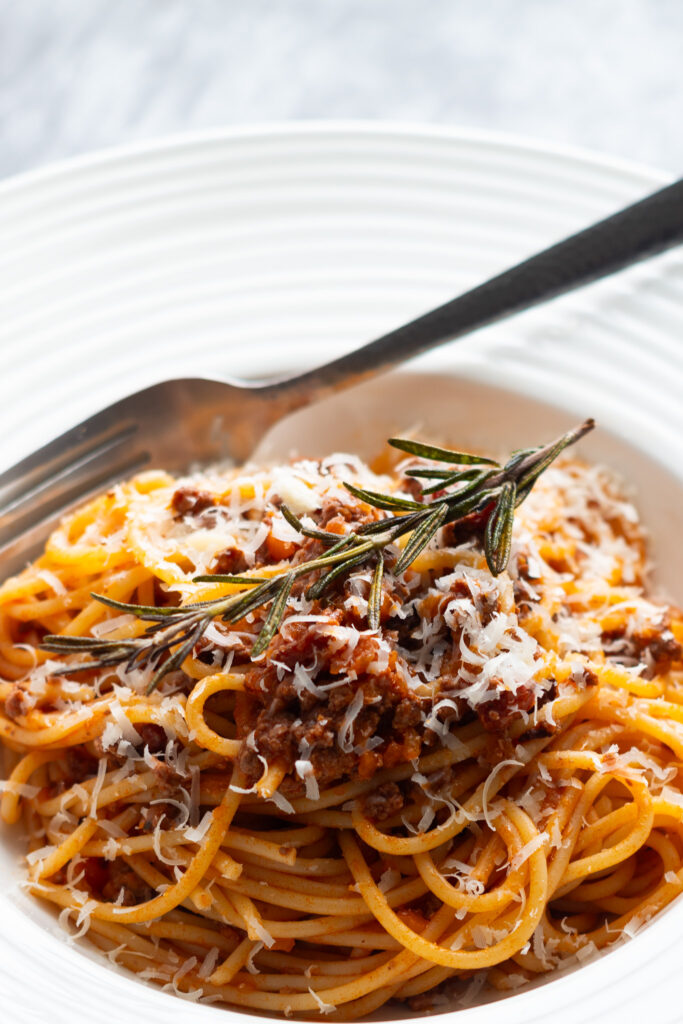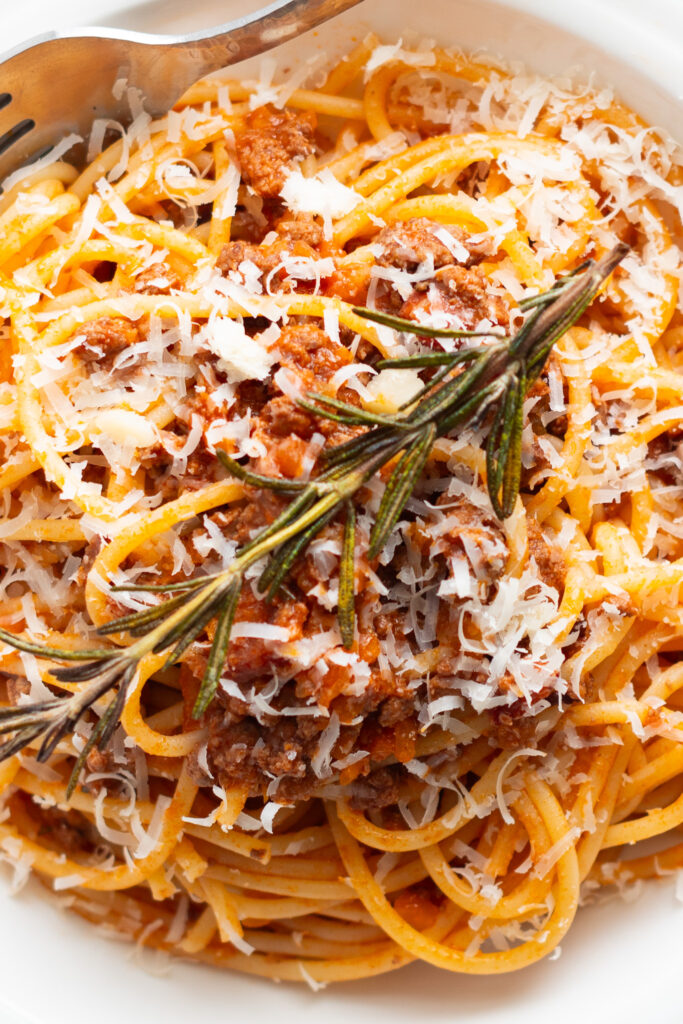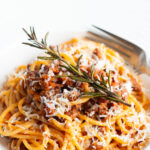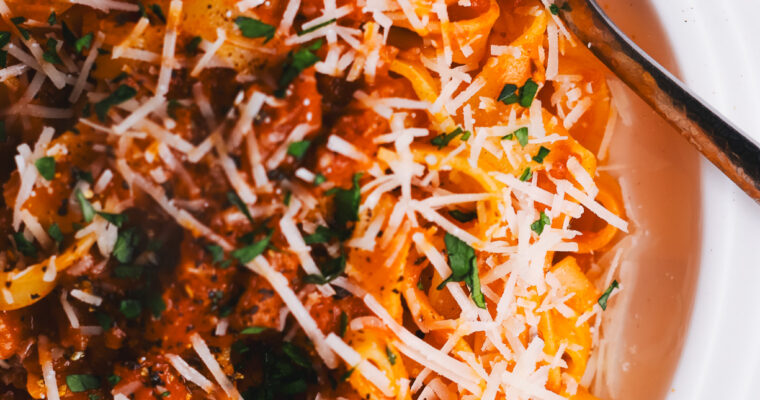Everyone thinks their version of Spaghetti Alla Bolognese is the one — but hear me out. This recipe is slowly simmered for over 2 hours with red wine, passata, and loads of flavour, resulting in a sauce that’ll make your kitchen smell like a proper Italian trattoria.
Crack on some music, pour a cheeky glass of red, and let’s do this.

What Is Spaghetti Bolognese?
Spaghetti Bolognese — or “Spag Bol” as we know it — is inspired by the traditional Ragù alla Bolognese from Bologna, Italy. That said, it’s taken on a life of its own in home kitchens around the world (especially here in the UK!). Think: a rich meat sauce with soffritto, tomatoes, herbs, and wine, cooked low and slow for maximum flavour.
Pro Tip: The key to a proper Bolognese? Time. Let it simmer. Stir occasionally. Let those flavours meld together.
If hearty, slow-cooked sauces are your style, you’ll love exploring more dishes in my pasta recipes collection
Bolognese vs Ragù vs Carbonara: Quick Rundown
Carbonara = Totally different – made with eggs, cheese, and pancetta
Bolognese = A type of ragù made with minced meat, wine, and milk
Ragù = Can be made with various cuts of meat, with or without tomatoes
Equipment
- Large skillet or Dutch oven
- Chef’s knife
- Food processor
- Wooden spoon

Ingredients
Here’s what goes into my version of this classic:
Spaghetti – or tagliatelle if you’re feeling fancy
Carrot, onion, celery – blitzed into a soffritto base
100% beef mince – I skip the pork but feel free to mix it up
Red wine – adds depth and heartiness
Rosemary – chopped in the sauce + whole sprigs fried for garnish (optional but fab)
Smoked pancetta – optional but brings that extra oomph
Whole milk – adds richness and smooths acidity
Passata + tomato purée – smooth, silky base
Parmesan – because obviously
How To Make Spaghetti Alla Bolognese
Make the Soffritto
- Blitz carrot, onion, and celery in a food processor until fine.
- Gently sweat in olive oil over low heat, partially covered, for 15–20 minutes, stirring occasionally. Low and slow – no browning!
2. Brown the Meat
- In another pan, fry the pancetta until it starts to crisp.
- Add beef mince, cook until browned and broken down.
3. Combine & Build the Sauce
- Stir the meat into the softened veg.
- Add chopped rosemary, cook for 2 minutes.
- Add tomato purée, cook 2 more minutes.
- Pour in red wine – let it simmer down until almost gone.
- Add passata + water, bring to a boil, then reduce to a low simmer.
4. Simmer Slowly
- Simmer uncovered for 2 hours, stirring now and then.
- Add water if it gets too thick or starts sticking.
5. Finish the Sauce
- Stir in whole milk, simmer for another 30 minutes.
6. Cook the Pasta
Drain and toss with the sauce (not just on top – coat that pasta!).
Boil your spaghetti until al dente. Salt the water like the sea!

Optional Variations
Mix in a splash of cream instead of milk for a decadent twist
Add a splash of Worcestershire sauce
Try Italian seasoning or fresh thyme
Use garlic (finely chopped) for extra flavour
Replace water with stock for a richer sauce
FAQ’s
Add sugar to help cut the acidity from the tomatoes used, usually cheaper varieties. I have found using milk can do a similar job. This recipe doesn’t need the sugar but as always – taste, taste, taste! You can always add it if you feel your version needs it.
The answer is usually the longer the better! You could make this recipe with around 30 minutes or so of simmering time, whilst cutting out the water used. It would still have flavour but the magic in this recipe is the slow simmer.
I make Spag Bol with spaghetti but you can use any of your favourite pasta. My favourite pasta is spaghetti, tagliatelle and rigatoni and I have used it with all of them equally well. If you don’t have any pasta try it with rice
Watch How I Make It
Spaghetti Alla Bolognese
Ingredients
- 400 g Beef Mince
- 400 ml passata
- 2 tbsp tomato puree
- 1 carrot
- 1 celery stick
- 1 onion
- 1 tbsp of chopped rosemary around 1 large sprig
- 400 ml water more as needed
- 100 ml whole milk
- 1 rosemary sprig fried per person for garnish.
- Grated parmesan cheese
- 100 g dried spaghetti per person
- 100 g smoked diced pancetta (optional)
Instructions
- Begin by roughly peeling and chopping your vegetables then place them all in the blender and blits to a very fine dice but quite a puree
- Add the blitzed vegetables to a preheated casserole dish with olive oil and simmer on low heat. Partially cover with a lid and leave to gently soften for around 20 minutes, stirring regularly to make sure nothing sticks. The heat should be low, a gentle sizzle. The aim is not to devlep colour on the vegetables.
- Whilst the vegetables simmer, fry off the pancetta over medium high heat in another pan until it starts to colour, then add the mince and cook through until well browned, breaking it up with the back of the spoon as you go.
- Once the vegetables have softened and visibly reduced slightly, add the browned mince and stir to fully combine.
- Add the chopped rosemary, stir and cook for 2 minutes
- Add the tomato puree and cook out for 2 minutes
- Now add the glass of red wine and bring to a lively simmer – continue to cook until virtually all the red wine has reduced down to nothing
- Add the tomatoes and water then bring up to the boil and reduce to a gentle simmer
- Simmer uncovered for 2 hours, stirring regularly and adding more water if required
- After 2 hours, add the whole milk, stir and simmer for 30 minutes
- Cook the spaghetti around 10 minutes from when you want to serve.
- Taste and seaason, then add the sauce to the drained spaghetti and toss to combine thoroughly before plating in pasta bowls
- Finish with freshly grated parmesan and fried rosemary sprig (if using)
Notes
- To make the fried rosemary sprigs, simply heat a little olive oil in a frying pan over medium-high heat and cook for around 15 seconds on each side, then place on kitchen towel. This can be done whilst the pasta is boiling.
- Check the sauce regularly and stir to make sure nothing is sticking or burning.
- Simmer the sauce uncovered to allow the meat sauce to reduce, thicken and come together properly
- Salt your pasta water. I use a large handful per pot of water that I use for boiling pasta. It may seem like a large amount of salt but the pasta needs it to give it flavour. It doesnt absorb it all and you can’t really overdo it. Think seawater salty!
More Recipes
Find more ideas in my Easy Pasta Recipes collection.

Hi, I’m Paul! I’m a passionate home chef, recipe developer, and food lover who believes that cooking should be fun, rewarding, and stress-free! Through Scoffs & Feasts, I share my favorite tried-and-tested recipes, cooking tips, and troubleshooting advice to help home cooks gain confidence in the kitchen. Whether you’re a beginner or an experienced foodie, I hope my recipes inspire you to try something new.



